Question-------------------------
Followup To
Question -
My pet beagle, Rusty has always been one to either urinate or 'the other way' inside, at night, when nobody is watching. These days, we have stopped him from doing this, temporarily, by putting two baby gates around his dog bed in the corner, like a cage. Whenever he is in the cage, he doesn't do this, yet recently, when we let him out of the cage, for we would want him out of the enclosed space just as he would, he, as Rusty doesn't do this every night, normally, goes all over the entire span of the room, when normally, he only leaves one or two droppings. Still, when we let him out during the day, he only urinates outside, even during long walks. What should I do?
Answer -
Hi, Kor. Thanks for asking! I have a few questions for you before I can get to answering your question.
1. How long is he expected to 'hold it' before being allowed outside to eliminate?
2. What does his feeding schedule look like? Do you feed him one or more times a day or do you leave food down for him all the time?
3. If you feed him once or more, when is his last meal before bedtime, and when is he taken out before bedtime?
4. What do you feed him?
Before I can accurately answer your question, I need to know these things, in order to assess what might be going on here. I appreciate your response.
Kristen
Reply
------------
To answer your questions, Rusty is normally let out at the time he wakes up (usually ranging from 7 to 8A.M.), after he finishes eating his one meal for the day, (this time always changes, depending on how hungry he is) and before he goes to bed, (normally at about 9 P.M.). When he refuses to eat any more, for he has become inevitably spoiled, his food is taken away by 6 P.M. This food is Purina brand Little Bites Dog Chow, with a little bit of water mixed in, to make it moist, as he normally likes it. Also, if it may be of importance to you, he is given a treat when he finishes his one meal, to encourage him to do so.
AnswerThanks for getting back to me so quickly!
Ok, I think the main part of the problem stems from the fact that you're leaving his food down all day, and are not taking him out to potty regularly. Rather than doing that, he needs to be put on a little bit more structured schedule as far as feeding goes, and given more opportunities to go potty outside. If he knows he'll soon be let out, he'll be less likely to 'go' inside. He should be taken out at least every 7-8 hours to pee.
As for the feeding schedule, you can choose to either feed him once or twice a day. Twice a day might be easier on him since he's used to grazing throughout the day. If you want to only feed him once a day, you can gradually phase out that second meal by feeding a little more at the first meal and not feeding as much at the second meal until the entire amount is being fed at the first meal. This transition should take about a week to go from start to finish.
But to start off, take whatever his normal daily amount is and split it in half. In the morning, around 8 or 8:30 (or whenever you usually put his food down), feed him as usual. If he isn't in the room, bring him in the room and let him see you put the bowl down. Leave the bowl down for 20-30 minutes, and then take it back up. If he hasn't finished, or even if he hasn't even started to eat, that doesn't matter. The bowl should be picked up and put away 30 minutes after being put down. Dump whatever's left in the bowl back into the dog food container. Wait about 10 minutes after putting the bowl away and then take him outside on a 4-6ft. leash. Generally, dogs have a bowel movement within 20 minutes of eating. When you take him out, walk him around a bit, because walking stimulates the bowels. Let him pee if he needs to, but only once. If he tries to pee more than once, he is not doing it because he has to go; he's doing it because he's marking. Potty time is not the time for marking, so do not allow him to pee more than once when you take him out to potty. When you notice him starting to show signs of having to poo (ie: circling, squatting), stop and let him go. You should not say a word to him until after he has completely finished. When he has, praise him like he's just won you $50 million. Play with him if you want, and if you have a fenced yard, take off his leash and let him run around if he wants to. This is to let him understand that going potty outside is a wonderful thing that gets him lots of praise and attention, and results in playtime with you. You don't have to play for long, just a few minutes - but you should make a very big deal of it. There's no such thing as acting too goofy or silly when praising a dog. After a few minutes, take him back inside and give him a treat. This treat should be a very special one; one that he ONLY gets after he goes to the bathroom outside. Bil-Jac brand liver treats are good for this purpose because they're small and very tasty. Plain, cooked chicken cut up into little pieces (about 1cm. squares) also works well.
If he doesn't poo within 5 or so minutes of walking around when you take him out, simply take him back inside. Don't say anything to him, don't give him a treat, and don't praise or play with him. Wait 10 minutes or so and try again. If he hasn't had a bowel movement after being taken out two or three times, then he most likely isn't going to go. Take him back inside and put him in his crate if you're going to be leaving, or you can leave him loose if you're going to be staying for a while. Just be sure to keep an eye on him. Preventing housetraining 'accidents' is the absolute best way of making them stop altogether.
In the afternoon, when you get home, or around 5:30pm, feed him the other half of his daily meal. Leave it down for 30 minutes, and then remove it again. He will probably eat at this meal, so you shouldn't have to dump any back into the dog food container. Within a day or so, he will have learned that if he doesn't eat when you put the bowl down, he isn't going to get another opportunity to eat until the next mealtime. A missed meal or two will not hurt him one bit. You will notice, however, that as he becomes accustomed to the schedule, he will also start having bowel movements when you take him outside to do so, and hopefully stop doing them indoors. Make sure not to forget to praise him and make a big deal out of it, then treat him with the special treat when you go back inside. Keep up this routine for at least 3 weeks before starting the transition over to just one meal a day if you choose to do that instead of twice a day.
Another thing you may want to consider is changing his food. Purina foods are notorious for causing soft stool and frequent bowel movements because of all the corn and other 'fillers' they contain. Brands like Iams, Eukanuba, Science Diet, and Pedigree are the same way. They contain undigestible ingredients like corn and animal fat, as well as things that many dogs are allergic to - corn, soy, wheat, and even some protein sources like beef.
A few new choices would be:
+ Nutro Natural Choice (they also have a 'little bites' formula) http://www.nutroproducts.com/naturalchoicedog.asp
+ Premium Edge http://www.premiumedgepetfood.com
+ Nature's Recipe (they have a breed specific formula for hound dogs) http://www.naturesrecipe.com
+ Solid Gold (they have a small breed formula) http://www.solidgoldhealth.com
+ Canidae http://www.canidae.com
+ Wellness http://www.oldmotherhubbard.com
+ Three Dog Bakery http://www.threedog.com
If you find a dog food in your area and wonder about it, feel free to ask me.
When trying to choose a good quality dog food, look at the ingredients label. As a general rule, in a good quality dog food, the first ingredient (ideally the first two ingredients) should be a meat protein source, such as chicken or chicken meal. If it is corn, put the bag down and walk away. The second ingredient (or third if the first two are a meat protein) can be a form of rice or oatmeal. The third (or fourth) ingredient should be either another meat protein source or a fat, or it can be another form of a grain like rice, barley, or millet if it is followed by another meat protein. Make sure the food is naturally preserved with mixed tocopherols instead of with chemicals like BHA, BHT, or propelene glycol (an ingredient in antifreeze).
If the following words are listed on the ingredients label, put the bag down and walk away:
-by-product
-digest
-corn
-soybean
-tallow - just as an fyi, tallow is not just beef fat. It is the hard deposits that form around the kidneys of the cow. It is completely undigestible, unlike chicken or poultry fat.
-BHA
-BHT
-propelene glycol
Here is the ingredients listing from the food I feed (Canidae). You can use it as a guide, as well as the ingredients listings on the websites I've provided for the dog foods I've recommended.
Chicken Meal, Turkey Meal, Brown Rice, White Rice, Lamb Meal, Chicken Fat (preserved with Mixed Tocopherols, Rosemary Extract), Herring Meal, Flax Seed, Sun Cured Alfalfa Meal, Sunflower Oil, Chicken, Lecithin, Monocalcium Phosphate, Potassium Chloride, Choline Chloride, Linoleic Acid, Rosemary Extract, Sage Extract, Yeast Culture, Dried Enterococcus Faecium, Dried Lactobacillus Acidophilus Fermentation Product, Dried Aspergillus Oryzae Fermentation Extract, Dried Bacillus Subtilis Fermentation Extract, Inulin (from Chicory root), Saccharomyces Cerevisiae Fermentation Solubles, Yucca Schidigera Extract Mixed Tocopherols (source of Vitamin E), Zinc Amino Acid Chelate, Manganese Amino Acid Chelate, Iron Amino Acid Chelate, Copper Amino Acid Chelate, Cobalt Amino Acid Chelate, Vitamin A Supplement, Vitamin D3 Supplement, Ascorbic Acid (source of Vitamin C), Niacin, Thiamine Mononitrate (Vitamin B1), Riboflavin (source of B2), Beta Carotene, Calcium Pantothenate, Pyridoxine hydrochloride (Vitamin B6), Calcium Iodate, Folic Acid, D-Biotin, Sodium Selenite, Dried Papaya, Vitamin B12 Supplement.
When you change him over to a new food, do it over a 1 week period. Start out mixing 1/4 of the new food in with 3/4 of his old food. Do this for a few days, then up it to 1/2 and 1/2. Do this for a few days and then up it to 3/4 of the new food and 1/4 of the old food. Again for a few days and then he should be getting 100% new food.
Though the foods I recommended do cost a little more per bag (they are about $1 a pound, give or take), when you start using them, you will notice that it equals out because you won't have to feed him as much food per day, and you'll have less to clean up as his bowel movements shrink, become more firm, and possibly less stinky. With those foods, since they contain more nutritious digestible ingredients, you should be able to cut his feeding amount per day by at least 1/4 cup to keep him at the weight he's at now. This means the bag of food will last longer, and as a result of that, you end up paying about the same as you are now for food that is mostly going straight through him. Do the math now, and then do it again after two or three bags of new food, and you'll see what I mean. Write down how much you spend on a bag of dog food now, and how often you have to buy it per month or even per year. Then, when you start feeding the new food, write down how much you spend on a bag, and see how long it lasts. With the new food, you'll have to wait until at least the 2nd or 3rd bag to get accurate results because of the transition period of figuring out how much of the new food to feed and for him getting used to the schedule. I can guarantee that you'll discover that you're paying about the same as you are now, but that you're cleaning up less and that he's seeming to be more healthy.
----------------------------------------------------------------------------------------------
I apologize for this being so long, but there's a lot of info in here for you. To recap, try putting your dog on a feeding schedule, whether you want to feed him once or twice a day is up to you, but make sure it's at approximately the same time each day. In turn, try to keep him on a potty schedule as well, taking him outside within 10 minutes of his finishing his meal. When you are not there to watch him, and at night, keep him either crated or sectioned off by the baby gates as you say you have done. Consider switching to a better quality food to not only make him more healthy, but to cut down on the amount (and consistency) of poo you are having to clean up.
Good luck, and PLEASE don't hesitate to ask if you need anything else. I promise all of my responses aren't this long!
Kristen

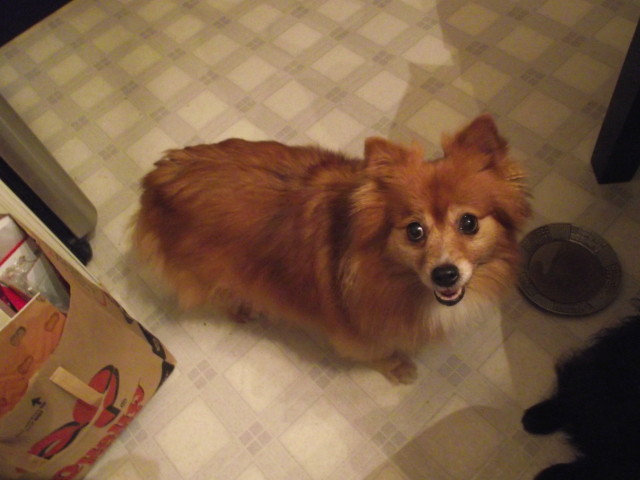 Pomeranian or Pomeranian mix
Question
Brandy my Pomeranian
Hi I have a Dog na
Pomeranian or Pomeranian mix
Question
Brandy my Pomeranian
Hi I have a Dog na
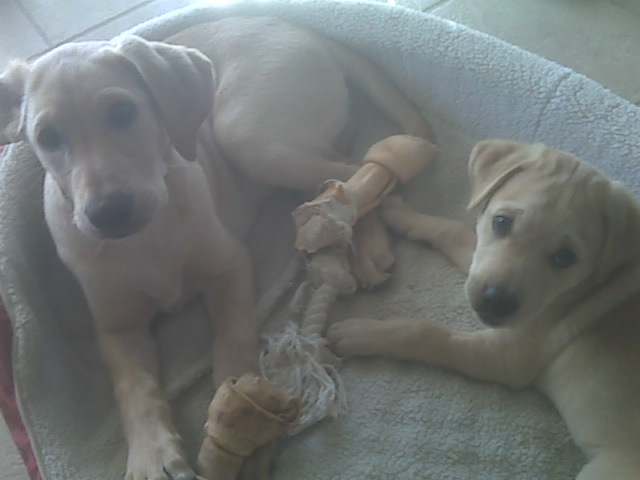 2 puppies one lab the other lab/shepherd mix
Question
Bailey ( female lab) a
I have a 3 1/2 month ol
2 puppies one lab the other lab/shepherd mix
Question
Bailey ( female lab) a
I have a 3 1/2 month ol
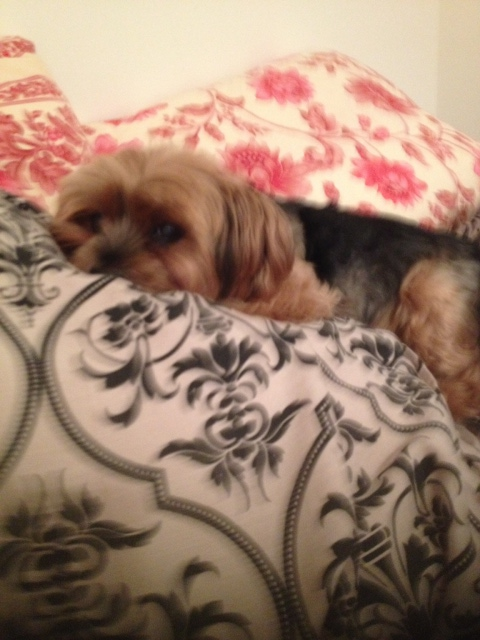 Cant afford medical care for my yorkie
Question
Mr. Bojangles BoBo
Hi, I adopted
Cant afford medical care for my yorkie
Question
Mr. Bojangles BoBo
Hi, I adopted
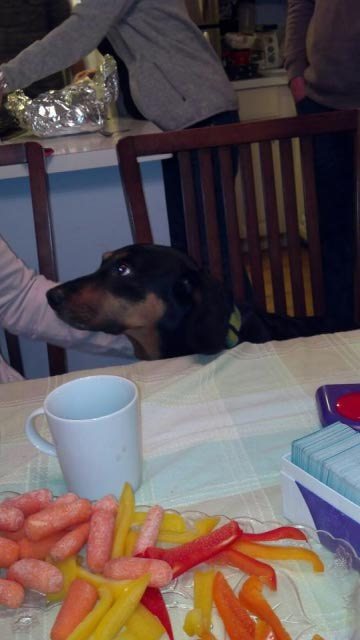 Gnawing/ Uncontrollable Itch
Question
Burgess
My wonderful dog Burgess, A Dac
Gnawing/ Uncontrollable Itch
Question
Burgess
My wonderful dog Burgess, A Dac
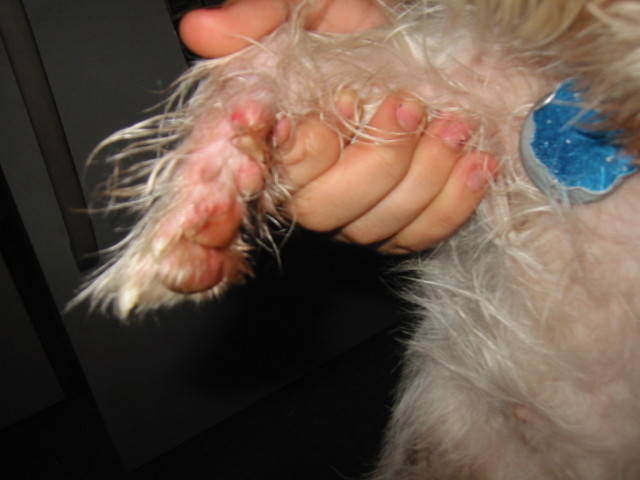 dew claw bleeding
Question
tashas paw
Hi I have a 2yr old female shutzu/M
dew claw bleeding
Question
tashas paw
Hi I have a 2yr old female shutzu/M